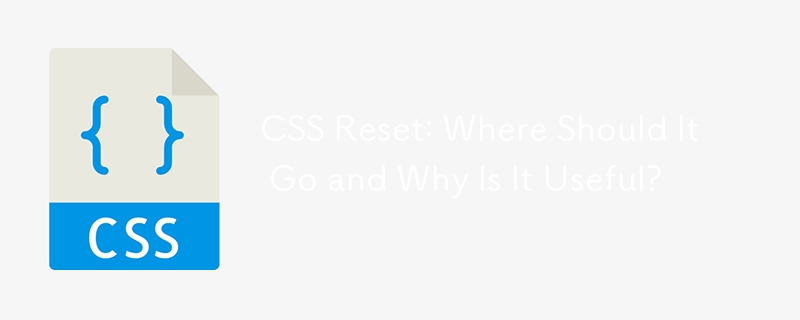CSS Reset: Where Should It Go and Why Is It Useful?

CSS Reset: Unraveling Its Functionality
The enigmatic "reset.css" file, often encountered in web development, has sparked curiosity among developers. What exactly does it do, and where should it be placed in the HTML document?
Purpose of CSS Reset
CSS reset, as its name suggests, aims to eliminate inconsistencies in browser-specific styling. In the early days of web development, browsers had varying interpretations of CSS properties, leading to unpredictable results. CSS reset addresses this issue by overriding browser defaults and standardizing element styles to a bare minimum.
The code snippet provided in the question exemplifies a typical CSS reset. It sets all margins and paddings to zero, eradicates borders and outline styles, and normalizes font styles and sizes. This ensures that elements appear uniformly across different browsers.
Placement of CSS Reset
The optimal placement of CSS reset is at the beginning of the HTML document, before any other stylesheets are loaded. This guarantees that browser defaults are overridden immediately, preventing any subsequent stylesheets from inadvertently restoring them.
Benefits of CSS Reset
Using CSS reset offers several advantages:
- Creates a consistent styling foundation across browsers, minimizing the need for browser-specific adjustments.
- Improves code readability and maintainability by reducing the need for workarounds to address browser inconsistencies.
- Simplifies the debugging process by eliminating unexpected and inconsistent styles.
Recommendation
It is generally recommended to incorporate CSS reset in web development projects. It provides a robust and standardized styling foundation that can enhance the user experience and simplify development efforts.
For further insights, the mentioned article, "Should you Reset Your CSS?", delves deeper into the merits and considerations surrounding CSS reset.
The above is the detailed content of CSS Reset: Where Should It Go and Why Is It Useful?. For more information, please follow other related articles on the PHP Chinese website!

Hot AI Tools

Undresser.AI Undress
AI-powered app for creating realistic nude photos

AI Clothes Remover
Online AI tool for removing clothes from photos.

Undress AI Tool
Undress images for free

Clothoff.io
AI clothes remover

Video Face Swap
Swap faces in any video effortlessly with our completely free AI face swap tool!

Hot Article

Hot Tools

Notepad++7.3.1
Easy-to-use and free code editor

SublimeText3 Chinese version
Chinese version, very easy to use

Zend Studio 13.0.1
Powerful PHP integrated development environment

Dreamweaver CS6
Visual web development tools

SublimeText3 Mac version
God-level code editing software (SublimeText3)

Hot Topics
 1663
1663
 14
14
 1420
1420
 52
52
 1313
1313
 25
25
 1266
1266
 29
29
 1239
1239
 24
24
 Google Fonts Variable Fonts
Apr 09, 2025 am 10:42 AM
Google Fonts Variable Fonts
Apr 09, 2025 am 10:42 AM
I see Google Fonts rolled out a new design (Tweet). Compared to the last big redesign, this feels much more iterative. I can barely tell the difference
 How to Create an Animated Countdown Timer With HTML, CSS and JavaScript
Apr 11, 2025 am 11:29 AM
How to Create an Animated Countdown Timer With HTML, CSS and JavaScript
Apr 11, 2025 am 11:29 AM
Have you ever needed a countdown timer on a project? For something like that, it might be natural to reach for a plugin, but it’s actually a lot more
 HTML Data Attributes Guide
Apr 11, 2025 am 11:50 AM
HTML Data Attributes Guide
Apr 11, 2025 am 11:50 AM
Everything you ever wanted to know about data attributes in HTML, CSS, and JavaScript.
 A Proof of Concept for Making Sass Faster
Apr 16, 2025 am 10:38 AM
A Proof of Concept for Making Sass Faster
Apr 16, 2025 am 10:38 AM
At the start of a new project, Sass compilation happens in the blink of an eye. This feels great, especially when it’s paired with Browsersync, which reloads
 How We Created a Static Site That Generates Tartan Patterns in SVG
Apr 09, 2025 am 11:29 AM
How We Created a Static Site That Generates Tartan Patterns in SVG
Apr 09, 2025 am 11:29 AM
Tartan is a patterned cloth that’s typically associated with Scotland, particularly their fashionable kilts. On tartanify.com, we gathered over 5,000 tartan
 How to Build Vue Components in a WordPress Theme
Apr 11, 2025 am 11:03 AM
How to Build Vue Components in a WordPress Theme
Apr 11, 2025 am 11:03 AM
The inline-template directive allows us to build rich Vue components as a progressive enhancement over existing WordPress markup.
 PHP is A-OK for Templating
Apr 11, 2025 am 11:04 AM
PHP is A-OK for Templating
Apr 11, 2025 am 11:04 AM
PHP templating often gets a bad rap for facilitating subpar code — but that doesn't have to be the case. Let’s look at how PHP projects can enforce a basic
 Programming Sass to Create Accessible Color Combinations
Apr 09, 2025 am 11:30 AM
Programming Sass to Create Accessible Color Combinations
Apr 09, 2025 am 11:30 AM
We are always looking to make the web more accessible. Color contrast is just math, so Sass can help cover edge cases that designers might have missed.




